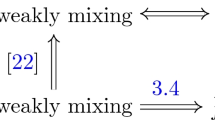Abstract
In this paper we study real linear dynamical systems\(\dot x = Fx + Gu,y = Hx,x \in R^n \) = state space,u ∈ R m = input space,y ∈ R p = output space, under the equivalence relation induced by base change in state space; or in other words we study triples of matrices with real coefficients (F, G, H) of sizesn × n, n × m, p × n respectively, under the action(F, G, H.) →(TFT −1,TG, HT −1) ofGL n (R), the group of invertible realn × n matrices. One of the central questions studied is: “do there exist continuous canonical forms for this equivalence relation?”. After various trivial obstructions to the existence of such forms have been removed the answer is very roughly: no ifm ≥ 2, p ≥ 2, yes ifm = 1, orp = 1. For a precise statement cf. theorem 1.7.
Existence or nonexistence of continuous canonical forms is related to the existence of a universal family of real linear dynamical systems. More precisely continuous canonical forms exist if such a universal family exists and if the underlying vector bundle of this family is the trivial vector bundle. In the case studied we show that a universal family in the appropriate sense does exist.
The methods used are purely (differential) topological and in particular do not involve any algebraic geometry. There is a corresponding algebraic theory over any fieldk instead ofR which is the subject of part III of this series of papers.
Similar content being viewed by others
References
M. Hazewinkel, R. E. Kalman,Mobuli and Canonical Forms for Linear Dynamical Systems (to appear; a Preliminary Version of this is available as report 7504, Econometric Inst., Erasmus University, Rotterdam, 1975).
M. Hazewinkel, R. E. Kalman, On Invariants, Canonical Forms and Moduli for Linear, Constant, Finite Dimensional, Dynamical Systems, In: Proc. CNR-CISM symposium on “Algebraic System Theory”, Udine, 1975,Lect. Notes Economics Math. Syst. Theory 131, 48–60, Springer-Verlag, Berlin, Heidelberg, New York, 1976.
R. E. Kalman, P. L. Falb, M. A. Arbib,Topics in Mathematical Systems Theory, McGraw-Hill, New York, 1969.
N. E. Steenrod,The Topology of Fibre Bundles, Princeton Univ. Press, Princeton, N.J., 1951.
M. Hazewinkel,Moduli and canonical Forms for Linear Dynamical Systems III: The algebraicgeometic case. (To appear. Proc. Inst./Sem. on Diff. Geometry for Control Engineers. Ames Research Centre (NASA), June/July 1976; a preliminary version is available as report 7610, Econometric Inst., Erasmus Univ. Rotterdam), to be published: Math. Sci. Press.
C. Byrnes, N. E. Hurt, On the Moduli of Linear Dynamical Systems, to appear,Advances in Mathematics.
Author information
Authors and Affiliations
Rights and permissions
About this article
Cite this article
Hazewinkel, M. Moduli and canonical forms for linear dynamical systems II: The topological case. Math. Systems Theory 10, 363–385 (1976). https://doi.org/10.1007/BF01683285
Received:
Revised:
Issue Date:
DOI: https://doi.org/10.1007/BF01683285



